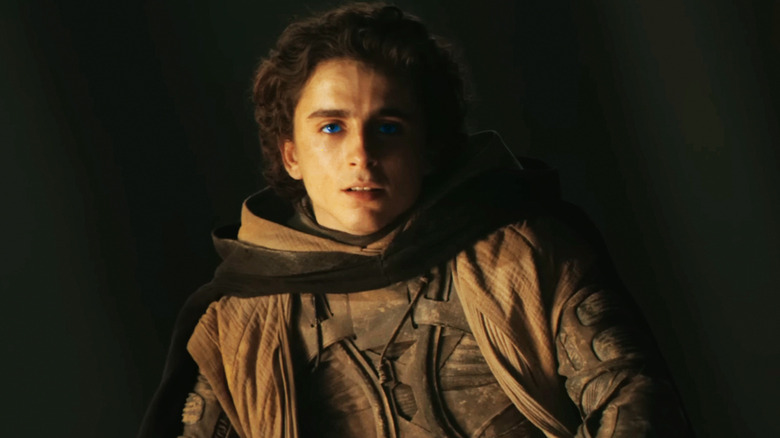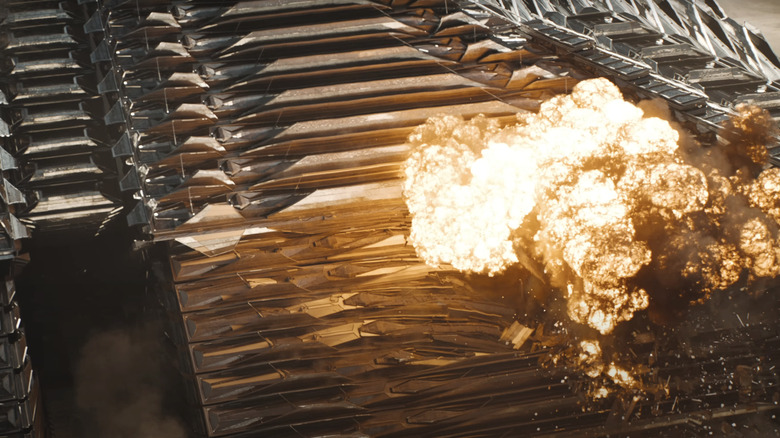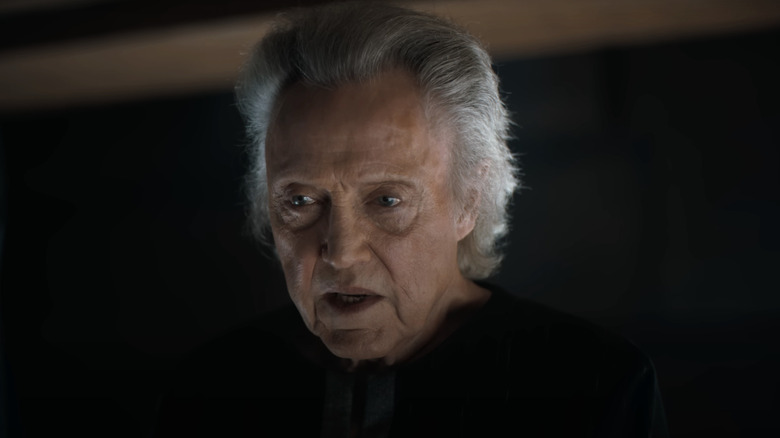One Of Dune: Part Two's Sets Was Inspired By A Rolex Watch
When "Dune" arrived back in 2021, it was released on Warner Bros.' HBO Max streaming service at the same time it debuted in theaters, which means many will have watched from the comfort of their own home and perhaps missed the truly epic scale of Denis Villenueve's adaptation of Frank Herbert's seminal sci-fi novel. Watching from home certainly left me with the sense that while "Dune" was undeniably well-crafted, it was also a little ... bleak. It seems "Dune: Part Two" has maintained the bleakness of the original, but this time, Villenueve's follow-up is getting an exclusively theatrical release. That means that if we want to see the movie when it debuts, we'll have no choice but to witness the grand scale of it in the way the director intended, which should go a long way toward enhancing the experience for many.
This should also mean audiences have a better chance of appreciating production designer Patrice Vermette's work. Regardless of how you felt about the look of "Dune," Vermette won an Oscar for his efforts on that film, and when you look into how he crafted the sets, it certainly seems well-deserved. In fact, if you weren't all that impressed with the visual style of "Dune," a quick look into how it was developed might change your view. In 2021, Vermette spoke to /Film about how he was inspired by a stunning array of sources, revealing that he drew from medieval times, Japanese temple architecture, World War II bunkers, Aztec architecture, Brazilian brutalist architecture, and "sculptures from the Eastern life."
If that doesn't add much to your appreciation of the "Dune" style, perhaps you'll be interested to hear that, for "Dune: Part Two," it seems the designer and his team have incorporated more contemporary inspirations into their work.
Vermette was inspired by Rolex design for one Dune: Part Two set
Patrice Vermette told /Film back in 2021 that he wanted the worlds of "Dune" to "feel old and to feel real." As such, he and his team made sure the environments were full of "cracked walls," "chipped corners," and "moisture or moss" on the walls. It seems a lot of this approach came from Denis Villenueve, who didn't want outside interpretations contaminating his vision of Herbert's novel. Instead, the director instructed his colleagues to always reference the original book itself, rather than drawing from any other work based on the text.
For "Dune: Part Two," Vermette and company no doubt continued to adhere to this philosophy, but that doesn't mean they didn't look elsewhere for inspiration. Florence Pugh, who plays Princess Irulan in the sequel, spoke to Entertainment Weekly ahead of the film's release and revealed that she'd conversed with a designer about one set in particular. The Emperor's tent or "Hutment" is a base of operations for the deceitful Padishah Emperor Shaddam Corrino IV (played by Christopher Walken in "Dune: Part Two") during his time on Arrakis, and is made up of several interlocking levels. Pugh specifically mentioned this set in her EW interview, explaining:
"That final scene in the emperor's tent. One of the set designers was saying that they based it on a Rolex watch, like, on the way that the links went like this [interlocks hands] and then it was like, 'Wow that makes so much sense that the richest tent in the world is based off a big Rolex, like, this is amazing.'"
Rolex was an inspired choice for the Hutment
The story of "Dune" begins when ruler of the planet Caladan, Duke Leto Atreides (Oscar Isaac), is asked to oversee the planet Arrakis by Padishah Emperor Shaddam Corrino IV. But the Emperor has a nefarious plan to betray the Duke, leading to his death. In Denis Villeneuve's first film, the Emperor was kept entirely off-screen, but in "Dune: Part Two," we'll be seeing Christopher Walken in the role. Walken will no doubt deliver a suitably chilling performance as the man who set the calamitous events of "Dune" and its sequel in motion. But he's also given the production designers a new challenge, which they've seemingly taken in stride.
The Emperor's base of operations should project its inhabitants' inordinate power, and using Rolex designs as an inspiration is a pretty insightful choice. In Pugh's interview, she seems to indicate that Patrice Vermette and his team specifically focused on watch straps, using the metallic links as inspiration for the Hutment's interlocking levels. It's unclear exactly which straps the team were inspired by, as Rolex has a wide range of what they call "Bracelet types." But the point was obviously to convey the status of Padishah Emperor Shaddam Corrino IV through the opulence of his environment.
All of this just points to the dedication of Vermette and his designers and is a small but significant reminder that it might be worth checking out "Dune: Part Two" in theaters if you can, if only to really get a sense of the intricate and well-thought-out production design which might have passed you by last time around.
"Dune: Part Two" hits theaters on March 1, 2024.


